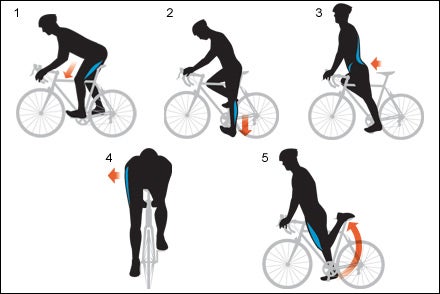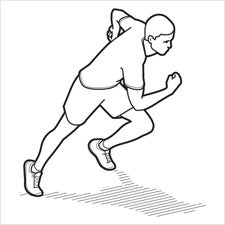The Warm-up Is Over
The Pillars of Fitness
To get in peak shape try out all four parts of our comprehensive series.IT’S TIME TO START CHASING YOUR AEROBIC-FITNESS GOALS IN EARNEST. Maybe it’s your first half-marathon or century, or maybe you have loftier ambitions ultramarathons or 24-hour mountain-bike races. Whatever the case, you’ve most likely been following a training philosophy that’s guaranteed to get you to the finish line but much more slowly than you’re capable of.
When left to their own devices, most recreational endurance athletes either rely too heavily on long, easy workouts or eventually fall into patterns of going moderately hard all the time. Both approaches are fine if you just want to have fun and stay fit, but neither will make you faster. To hit your cardio peak, you need to blend that steady endurance work with gut-busting intensity. And a rapidly growing body of research points to the gut busting as the key. You have to become your own best coach. This month we’re going to walk you through that.
If you followed the advice in the first installment of our four-part Pillars of Fitness series, “Building a Base” (March; outsideonline.com/pillar1) our guide to preparing your body for year-round fitness you should be feeling looser, stronger, more balanced, and more eager to go than ever. Good, because while we’re going to start scaling back the volume of your workouts, we’re going to up the intensity like never before.
Meet The Experts
NANNA L. MEYER: A doctor of exercise physiology with the University of Colorado at Colorado Springs, Meyer is a registered dietitian who’ll be offering advice for cardio fuel. Meyer raced alpine for the Swiss national ski team, and she is now a consultant to the United States Olympic Committee and serves as sports dietitian for U.S. Speed Skating.
CURTIS CRAMBLETT: In March, this USA Cycling coach and physical therapist helped us self-diagnose and treat physical imbalances. This month Cramblett walks us through the stretches that will help stave off injury during harder exercise. His instructional video “Active Stretching and Self Massage for the Cyclist and Triathlete” will be out in May.
NEAL HENDERSON: Known for providing customized training schedules to a diverse roster of both pro and amateur athletes from cyclists to runners to ice-hockey players exercise physiologist Henderson is the sport-science manager at the Boulder Center for Sports Medicine. This month he gives us advice on how to ramp up the intensity.
Step 1: Forget What You Know
Slow, long-distance workouts are great—for preparing your body to go slow for long distances
There’s a name for the training philosophy most people follow for endurance sports: long, slow distance (LSD). First heralded in 1969 by running coach Joe Henderson, LSD training is a proven method of building endurance by going easy for hours at a time20-mile runs, 100-mile bike rides, etc. These efforts teach the body (specifically the mitochondria in muscle cells) to burn fat, boosting the density of the mitochondria and getting more blood to the muscles. Which is a scientific way of saying endurance training makes us more efficient.
I’d never tried LSD training because it always sounded boring and because, as a recreational athlete, I don’t train so much as recreate. My rides were generally less than three hours, fast, and in the unstructured presence of friends. That changed last summer when I signed up for a French bike race called L’Etape du Tour. It’s an annual citizens’ race that follows an actual mountain stage of the Tour de France. In this case, I’d be joining 7,000 other riders for a 105-mile slog from the town of Pau to the mountaintop finish on Hautacam, in the Pyrenees, cresting the 6,939-foot Col du Tourmalet along the way.
I had never done a race longer than three hours, and this would take around twice that. Terrified that I wouldn’t be able to last, I devoted myself to eight weeks of LSD workouts. Sure enough, I developed endurance like I’d never known. But the explosiveness I’d earned over a winter of hilly skate skiing was gone. On race day I couldn’t close gaps or sprint up the climbs. I had plenty of energy left at the finish, but there was no way I could have gotten there any faster. LSD had made me a turtle.
“There’s a time and place for some form of steady aerobic training,” says Henderson, noting the fat-burning benefits. “But continuously training at that pace is not going to cause any novel stress. And without that positive stress, you can’t get faster. It’s time spent but not well spent.”
Recent studies support this. Last fall, researchers at Denmark’s University of Copenhagen ran an experiment on 17 endurance runners whose workouts consisted of about 28 miles per week of LSD training. For four weeks, nine of the runners were prescribed just six miles of distance training per week, plus an additional “speed endurance” regimeneight to twelve 30-second sprints separated by a few minutes of rest. The sprints, which they did a few times a week, amounted to another four miles of running, resulting in a total weekly distance of just ten miles. The rest of the runners stuck with their normal 28-mile routines. After four weeks, the control group’s fitness stayed about the same, but runners in the sprinting group lowered their oxygen uptake by an average of 6.6 percent, meaning that, at the same speeds, they weren’t working as hard.
“It’s unlikely that in real life, endurance athletes will replace all their aerobic training with speed-endurance training,” professor Jens Bangsbo, a 35-year soccer coach and a principal physiologist on the Copenhagen study, replied when I asked him if I could skip LSD training forever. “But there is scientific consensus that the physiological and performance adaptation from intensity training can be retained for long periods15 or more weeks Intense exercise seems to be superior to traditional endurance training, with the exception of muscle-fat oxidation.”
Of course, that last point about fat is why you shouldn’t eliminate all distance training. To excel at endurance, the body must be able to burn fats efficiently, or else you’ll bonk once your carb stores are depleted. And for that there’s still no substitute for steady distance work. But if your race goals are more ambitious than simply finishing, your focus should always return to intensity. To get fast, you’ve got to train fast.
Step 2: Get Faster by Going Faster
The good news: You've got an extra gear. The bad news:Shifting into it might hurt a little.
Neal Henderson's Four Tips Guaranteed to Make You Faster
1. Cut back on the volume: Your distance/hours per week need to be cut 20 percent during overload, and 3050 percent during maintenance periods.2. Increase carbohydrate intake. The extra intensity burns more carbs.
3. Increase rest and sleep time whenever possible during overload periods. Without rest, you can’t work hard and recover.
4. Reduce other stressors. Take a half-day or a full day off from work to boost training intensity, maximize recovery, and socialize with family and friends.
In the sample six-month periodization program we provided in March, we had you start off with a moderately difficult Maintenance 1 period to prep for the harder efforts ahead. Now we move into three months of intense stress and recovery, beginning with the four-week Overload 1 period detailed in the chart below.
This high-intensity training block is intentionally heavy on tough threshold work (which helps to push back the point at which lactate floods the muscle) and tougher VO2 intervals, which quickly stress the entire system and make you faster. Your threshold is the number from your March field test (outsideonline.com/fieldtest)an estimate of your upper limit for sustained aerobic performance. Your VO2 maxthe upper limit of your oxygen-delivery systemis roughly equal to the fastest pace you would be able to sustain for six minutes.
Step 3: Stretch Your Workout
Don't let that injury-dodging flexibility you've been working on since March fade as you ramp up your intensity. Try the following combinations of dynamic (moving) and static (stationary) stretches after a brief warm-up.

1. HAMSTRINGS
ON THE BIKE:
While coasting with your feet in the 3 o’clock and 9 o’clock positions, push your belly button down to the top tube and bring your chest down to the handlebars. To make it dynamic, shift your butt back back on the saddle. Switch legs and repeat.
ON THE TRAIL:
Put your foot up on a rock, branch, or other support that is about six to 12 inches higher than your knees. Keep your hips and feet pointing in the same direction as the leg you’re stretching, and pull your chest toward your knee.
2. CALVES
ON THE BIKE:
Stand in the pedals and drop one of them to the 6 o’clock position. Let your heel sink toward the ground. Contract the calf and gently lift up onto your toes for one to two seconds. Slowly work in and out of the stretch position several times, then switch legs.
ON THE TRAIL:
Basically the same as above, only you’ll be using a rock, log, or curb so that your heel can sink below the ball of your foot.
3. HIP FLEXORS AND BACK
ON THE BIKE:
With one foot at the bottom of the stroke and your hands firmly on the bars, lightly weight your hands and shove your hips forward while arching your back. Switch feet and repeat.
ON THE TRAIL:
Kick your foot up on that hip-height rock and contract the muscles of your abs and lower core. Shift your hips forward and sink into the stretch. You should feel the pull in the front of the hip and thigh.
4. IT BAND AND SIDE OF HIP
ON THE BIKE:
With your right pedal at 6 o’clock and your knee slightly bent, shift your right hip slowly to the outside until you feel a gentle tension in the muscles. Shift back to work the glutes. Shift forward to work the hips.
ON THE TRAIL:
With your left foot crossed over the right, push your right hip to the right while reaching over your head with your right hand. (You should look like a banana.) Go into the move slowly, with a little muscular tension, and feel the stretch in the top of your hip.
5. QUADS
ON THE BIKE:
With your left foot at 6 o’clock, unclip from your right pedal and pull your foot up and behind you until you can rest your forefoot on the saddle. Sit back on your heel. Keep moving in and out of this position on both sides.
ON THE TRAIL:
Pull your foot behind you and set it on a rock or the hood of a car. Nothing available? Just grab your foot and pull it toward your butt. Contract your lower abs and suck your belly button in toward your spine. Don’t let your knee drift to the side; keep it pointed straight down.
Step 4: Eat with Intensity
Get the most out of your workouts with foods that deliver the right nutritional spark
BEFORE: Carbo-loading improves performance for short, intense efforts as well as endurance workouts. But to get the benefit, you should eat at least two hours beforehandthree if it’s an especially long effort. For these pre-intensity meals, quickly digestible processed foods like pasta are ideal. “I wouldn’t eat salads or bread with the specks of grain in it,” says Meyer. “Raw food lingers in the stomach.”
DURING: Again, this is a time when processed stuff is your friend. During hard efforts, stick with a variety of gels, bars, and sports drinks instead of sandwiches and the like. They’re portable and easily digestible, and the labeling makes it easier to gauge your intakeaim for around 60 grams of carbs an hour (including drinks) for any event lasting longer than 90 minutes. For shorter, intense workouts, lean toward sports drinks, which transport nutrients to the bloodstream faster.
AFTER: Make sure to down a recovery drink immediately after any hard workout to start replenishing fluids, electrolytes, carbs, and protein. Following longer efforts (three-plus hours), plan to eat every hour for the next fourhow much depends on what you’re doing tomorrow and how big you are. Just don’t gorge: “It’s better to eat small meals repeatedly,” says Meyer. “The whole process of restoring protein, glycogen, and fats is more effective when you stretch the meals out. Try a variation on the traditional Italian diet, which serves up carbs (pasta), followed by proteins (lean meat and fish) and then salad. And don’t skip the panna cotta. “Trained athletes are better fat burners,” says Meyer. “And you need that fat to store in the muscle for the next day.”
Sample Exercises
Before each workout, warm up with an easy ten-minute ride or jog, then stretch.
DAY: MONDAY
DRILL:
Self-massage and core conditioning; 45 minutes.
INSTRUCTIONS:
Use a foam roller on your IT bands, calves, and hamstrings for 20 minutes. Then do ten minutes of planks and 15 minutes of ball crunches and back extensions.
DAY: TUESDAY
DRILL:
Threshold intervals, 60 (run) to 90 (bike) minutes. Intervals will be done just below lactate threshold. “Rest” means easy endurance/conversational pace.
INSTRUCTIONS:
BIKE:
Three 15-minute intervals with five to seven minutes of rest after each. Finish with six all-out sprints lasting five to 20 seconds, with five minutes of recovery after each.
RUN:
Three or four five-minute intervals with five minutes of recovery after each. The rest of your run should be at a moderate endurance pace.
DAY: WEDNESDAY
DRILL:
Strength and core work, 30 minutes.
INSTRUCTIONS:
Three sets of 1215 single-leg squats with dumbbells to retain muscle mass. Next do a 20-minute version of Monday’s core workout.
DAY: THURSDAY
DRILL:
VO2 max intervals, about 45 minutes. Training at your VO2 max provides the positive stress you need for speed.
INSTRUCTIONS:
BIKE:
Three to five intervals of three to five minutes apiece, with equal recovery after each. As your conditioning improves, try four eight-minute intervals.
RUN:
Four intervals of three to five minutes at 95 percent of your best one-mile time, with equal rest after each.
DAY: FRIDAY
DRILL:
Sub-max beer drinking, feet on sofa.
INSTRUCTIONS:
Boost your carb intake with a White Rascal wheat beer.
DAY: SATURDAY
DRILL:
Optional tempo training, 45 minutes with warm-up. “Tempo” is equivalent to 95 percent of your threshold pace.
INSTRUCTIONS:
RIDE OR RUN:
Tempo pace for 2045 minutes. This is that moderate effort most of us revert to when left on our own. But feel free to take this day off.
DAY: SUNDAY
DRILL:
LSD: Make this ride or run at least as long asor up to 50 percent longer thanyour goal event.
INSTRUCTIONS:
Stay at a conversational pace. If you have a heart-rate monitor, keep your pulse 20 to 25 beats below threshold. Do this three of the four weeks during your overload period. On the fourth, rest.


